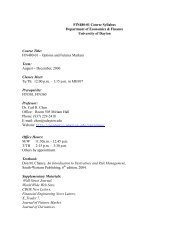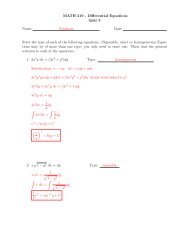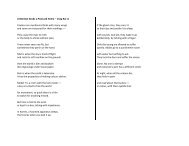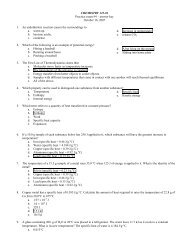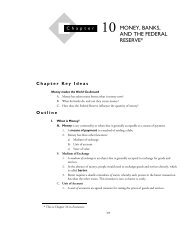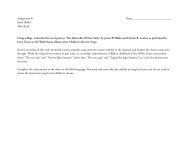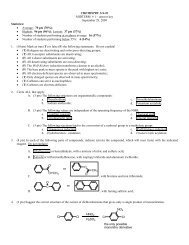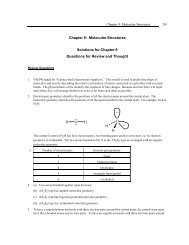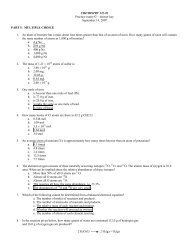Physics 206 Example Problems Newton's Laws of Motion
Physics 206 Example Problems Newton's Laws of Motion
Physics 206 Example Problems Newton's Laws of Motion
You also want an ePaper? Increase the reach of your titles
YUMPU automatically turns print PDFs into web optimized ePapers that Google loves.
I have assumed directions for the rod force on the blocks. All that I know for sure is that the forces that<br />
the rod exerts on the masses are equal and opposite, so T may come out to be positive or negative.<br />
Applying the second law in the y-direction on mass 1 gives,<br />
Fnet, y = m1 a1 y = 0 ⇒ N1 − m1 gE cosθ = 0 ⇒ N1 = m1 gE cosθ ( 6)<br />
Similarly the second law applied in the y-direction for mass 2 gives,<br />
Fnet, y = m2 a2 y = 0 ⇒ N2 − m2 gE cosθ = 0 ⇒ N2 = m2 gE cosθ ( 7)<br />
The second law applied in the x-direction for mass 1 gives,<br />
T − µK1 N1 + m1 gE sinθ = m1 a1 x<br />
The second law applied in the x-direction for mass 2 gives,<br />
− T − µK2 N2 + m2 gE sinθ = m2 a1 x<br />
A) Note that the two blocks have the same acceleration. Using Equations 6 and 7 in Equations 8 and 9<br />
and then adding 8 and 9 gives,<br />
− ( µK1 m1 + µK2 m2 ) gE cosθ + ( m1 + m2) gE sinθ = ( m1 + m2) a1 x<br />
Solving for the acceleration component gives,<br />
a1 x = − ( µK1 m1 + µK2 m2 ) gE cosθ + ( m1 + m2) gE sinθ<br />
m1 + m2<br />
B) Dividing Equation 8 by m1 and Equation 9 by m2 and then taking the difference <strong>of</strong> the results gives,<br />
Simplifying gives,<br />
<br />
1<br />
T<br />
C) Note that if µK1 = µK2, then T = 0.<br />
m1<br />
+ 1<br />
m2<br />
<br />
− ( µK1 − µK2) gE cosθ = 0<br />
T = ( µK1 − µK2) gE cosθ m1 m2<br />
m1 + m2<br />
Problem 1 0. Your car is stuck in a mud hole. You are alone but have a long, strong rope. Having<br />
studied physics you tie the rope tautly to a telephone pole and pull on it sideways as in the figure below.<br />
A) Find the forces exerted by the rope on the car when θ = 3 ◦ and you are pulling with a force <strong>of</strong> 400<br />
N and the car does not budge.<br />
B) How strong must the rope be if it takes a force F <strong>of</strong> 600 N to move the car when θ = 4 ◦ .<br />
Car<br />
θ θ<br />
Solution :<br />
A) Apply the second law to the junction at which force the force F is applied. Call F1<br />
the force <strong>of</strong> the<br />
rope attached to the car on this junction and F2<br />
the force <strong>of</strong> the rope attached to the pole acting on this<br />
junction. In the diagram take up to +y and to the right +x. In this coordinate system I can write,<br />
F<br />
F<br />
Pole<br />
= − Fyˆ F<br />
1 = − T1 cosθ xˆ + + T1 sinθ yˆ F<br />
2 = T2 cosθ xˆ + T2 sinθ yˆ<br />
Applying the second law in the x-direction gives,<br />
Fnet, x = m ax<br />
− T1 cosθ + T2 cosθ = 0<br />
T1 = T2 ≡ T<br />
7<br />
( 8)<br />
( 9)<br />
( 1 0)<br />
( 1 1 )




